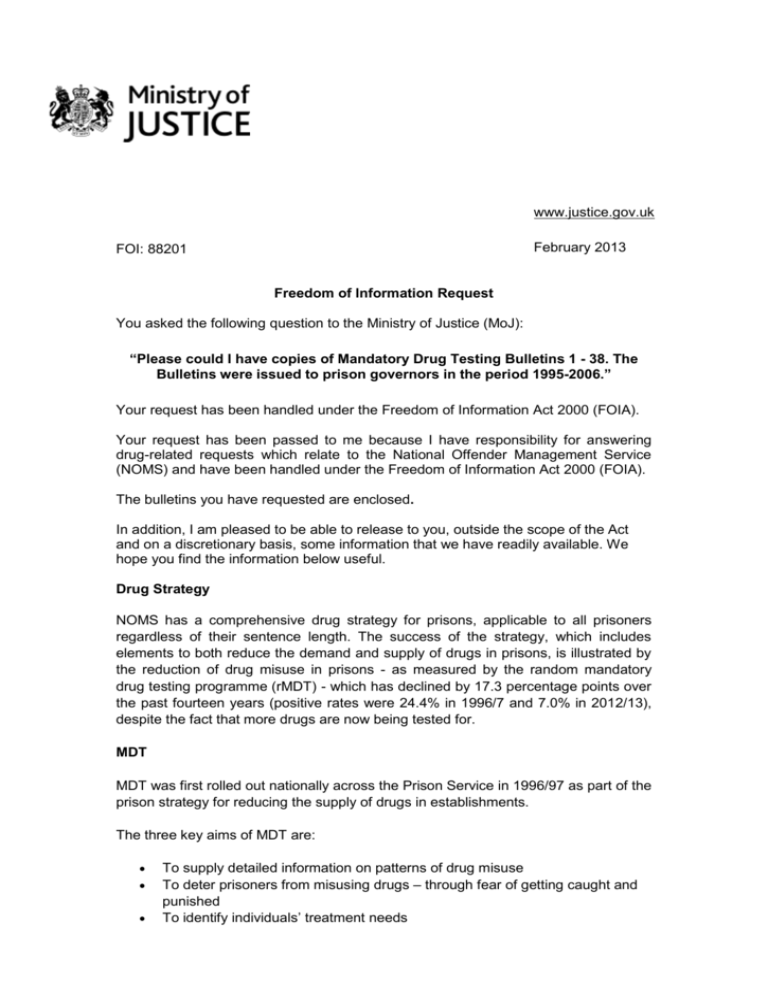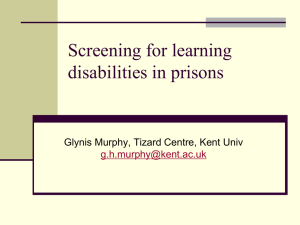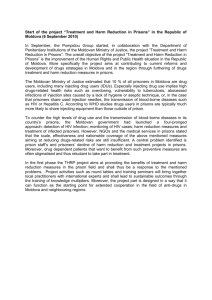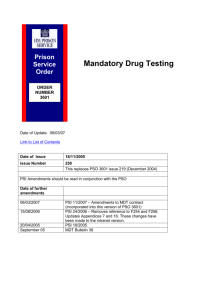Mandatory Drug Testing Bulletins
advertisement

www.justice.gov.uk February 2013 FOI: 88201 Freedom of Information Request You asked the following question to the Ministry of Justice (MoJ): “Please could I have copies of Mandatory Drug Testing Bulletins 1 - 38. The Bulletins were issued to prison governors in the period 1995-2006.” Your request has been handled under the Freedom of Information Act 2000 (FOIA). Your request has been passed to me because I have responsibility for answering drug-related requests which relate to the National Offender Management Service (NOMS) and have been handled under the Freedom of Information Act 2000 (FOIA). The bulletins you have requested are enclosed. In addition, I am pleased to be able to release to you, outside the scope of the Act and on a discretionary basis, some information that we have readily available. We hope you find the information below useful. Drug Strategy NOMS has a comprehensive drug strategy for prisons, applicable to all prisoners regardless of their sentence length. The success of the strategy, which includes elements to both reduce the demand and supply of drugs in prisons, is illustrated by the reduction of drug misuse in prisons - as measured by the random mandatory drug testing programme (rMDT) - which has declined by 17.3 percentage points over the past fourteen years (positive rates were 24.4% in 1996/7 and 7.0% in 2012/13), despite the fact that more drugs are now being tested for. MDT MDT was first rolled out nationally across the Prison Service in 1996/97 as part of the prison strategy for reducing the supply of drugs in establishments. The three key aims of MDT are: To supply detailed information on patterns of drug misuse To deter prisoners from misusing drugs – through fear of getting caught and punished To identify individuals’ treatment needs The five strands of the MDT programme are: Random testing - Prisoners will be selected for this test on a strictly random basis. Suspicion testing - Prisoners will be selected for this test where there is reason to believe that the prisoner has misused drugs. Frequent testing - Prisoners will be selected for this programme because of their previous history of drug misuse. Risk testing - Prisoners will be selected for this test when they are being considered for a privilege (such as release on temporary licence), or a job, where a high degree of trust is to be granted. On-reception testing - Prisoners may be selected for testing on reception on a routine or occasional basis. Powers to require prisoners to provide a sample for drug testing purposes were introduced as part of the Criminal Justice and Public Order Act 1994. On its own, MDT cannot solve the problem of drugs within prisons. It can, however, contribute to the overall objective of reducing drug misuse when used as part of a wider and more comprehensive drug strategy. The Prison Service Drug Strategy Tackling Drugs in Prison, published in May 1998, seeks to provide a more balanced and consistent approach with much greater emphasis on the provision of treatment and support programmes. This can only be done by implementing mandatory drug testing as part of a wider anti-drug misuse strategy. Mandatory drug testing impacts upon many areas of prison life and raises a complex series of legal, procedural and ethical questions. The specific objectives of mandatory drug tests are as follows: to increase significantly the detection of those misusing drugs and to send a clear message to all prisoners that if they misuse drugs they have a greater risk of being caught and punished; to help prisoners to resist the peer pressure often placed on them to become involved in drug taking, due to the increased possibility of detection; to help to identify prisoners who may need assistance to combat their drug problems with assistance offered to those who want it; to provide, by means of the random testing programme, more accurate and objective information on the scale, trends and patterns of drug misuse, allowing prisons to manage and target more effectively their resources for tackling drug problems; and to enable the proportion of prisoners testing positive for different drug types on the random testing programme to be used as one performance indicator of drug misuse. Further information on MDT can be found in the publicly available Prison Service Order 3601 http://pso.hmprisonservice.gov.uk/PSO_3601_mandatory_drugs_testing.doc. Drug Treatment NOMS has in place a drug treatment framework, based on the National Treatment Agency’s Models of Care, to address the needs of drug misusing prisoners. The interventions available are designed to meet the needs of low, moderate and severe drug mis-users – irrespective of age, gender or ethnicity - including the many that spend a comparatively short time in prison. Considerable improvements have been made in clinical drug treatment in prisons, in particular through the phased introduction of the Integrated Drug Treatment System (IDTS) - a treatment system, based on evidence, providing improved clinical management including prescribing and psychosocial interventions via multidisciplinary teams, particularly in the first 28 days of prison and also links with care and treatment services in the community. Drug Supply Reduction Prisons deploy a robust and comprehensive range of security measures to reduce drug supply – including: Passive search dogs, which are available in all prisons, to detect visitors carrying drugs. And active search dogs, used to search goods and vehicles. Strict measures to tackle visitors who smuggle or attempt to smuggle drugs, including – on suspicion of smuggling – ‘closed’ visits (i.e. through a glass screen) or visit bans, and arrest and prosecution where there is sufficient evidence; The criminal process is invoked against visitors and prisoners alike wherever sufficient evidence exists of an attempt to supply. A range of internal sanctions exists for prisoners caught using drugs; CCTV surveillance in most social visits areas and low-level furniture in social visits areas in all Category C prisons and above, to make it more difficult to pass drugs; Effective intelligence systems, targeting those trafficking drugs; Close working with the police to target serious criminals outside prison who are increasingly involved in supply. Each prison has access to a police liaison officer; Supply Reduction Good Practice Guide used by all prisons to improve performance. Regular review of the poorer performing prisons by regional Deputy Directors of Custody; Deployment of technology and strategies to detect and disrupt mobile phones, and analysis of recovered handsets and SIM cards a comprehensive programme of mandatory drug testing for prisoners and disciplinary sanctions for those testing positive.











